According to a recent CompTIA research on state of tech workforce, available supply is one of the major obstacles in hiring plans for organizations. Hiring strategy quickly runs into talent constraints.
One key alternative is internal training programs that help entry-level employees acquire skills quickly and start making a significant impact.
Still, this strategy, too, has its limitations. What can you do if you need a quick replacement for a mid- or senior-level expert? Are there any options?
Yes, there are. Choose IT staff augmentation.
You get both:
- empower the in-house team fast with seasoned experts
- save a seven-digit budget on hiring, onboarding, and training
This post guides you through the pros, cons, and staff augmentation examples. It also gives you insights on how to turn your in-house team and external specialists into a single, smoothly collaborating and working machine.
1
What is Staff Augmentation?
Staff augmentation definition is hiring an external workforce to complete certain tasks when a business lacks that specific in-house expertise.
Companies can opt for IT staff augmentation by subcontracting one or two specialists for either full- or part-time work. Or they can hire a dedicated team when a staff augmentation project requires several roles. Teams work relatively independently on delegated areas (e.g., one team works on a web app and another on a native iPhone app).
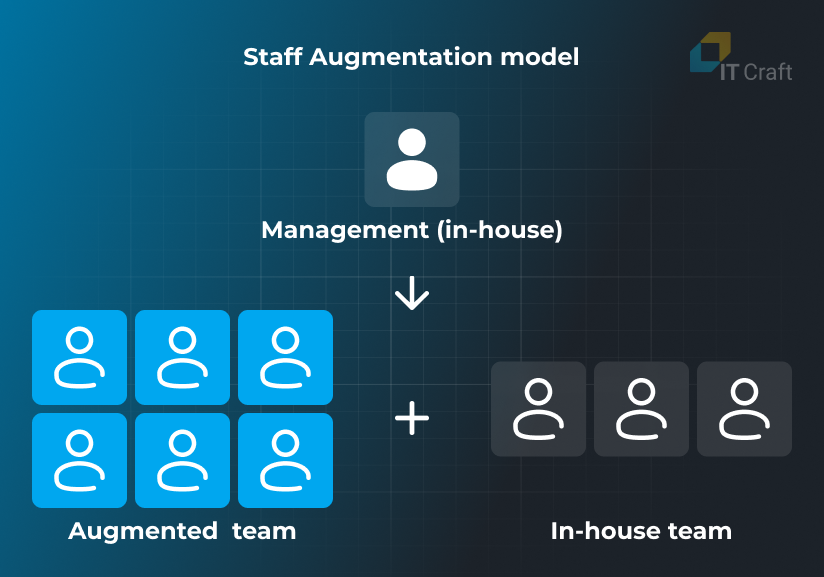
What does staff augmentation mean for an organization?
External team members do not become employees. The IT staff service provider is responsible for overhead costs, including recruitment, taxes and insurance, equipment, etc.
Hired specialists maintain direct communication with the client. A point of contact on the IT staff provider’s side handles all matters relating to the external workforce.
Overall, an extended team remains an external, temporary workforce:
- a line item in the budget
- hired temporarily
- working from any place in the world
2
How Does Staff Augmentation Work?
The staff augmentation process includes four consecutive steps, which you use to:
- formulate a request based on your needs
- look at a specializing provider or in the marketplace
- select and hire the best fit
- manage the hired specialists
The four practical steps to successful staff augmentation in more detail:
Determining needs
It is important to determine the requirements and expectations from candidates:
- early start – you need it when reaching an aggressive deadline
- scope and activities – you may need one or several engineers, or a team
- budget considerations – some regions can appear expensive
- communication – the contractor’s working ethics should not slow down your team
- measurable goals – think of metrics that engaging an expert on a temporary basis until the required work is complete
Also, keep in mind that you might need to make adjustments on your side (e.g., access to project documentation, creating corporate emails and profiles, special training, and more) to remove bottlenecks and ensure fast onboarding.
Talent Sourcing
At the next step, you search for an expert freelancer or an agency on specializing platforms, such as Upwork, Toptal, Clutch, or Goodfirms.
When hiring a freelancer, businesses gets independent professionals at a cost-effective rate. Yet, they need to factor in expensive managerial time communicating with freelancers.
Also, scaling might be time-consuming when several specialists are required, and each specialist lives in different parts of the world.
When turning to a dependable agency, businesses access available experts or get help recruiting the right remote specialist. Vendors can scale a team when required.
The vendor also takes part of responsibilities including HR management, accounting, reports, communication, and handles replacement if the specialist quits. It helps you save time your time and resources.
Staff Selection
Contact a vendor or a freelancer with your requirements, sign an NDA with them, and discuss possible options.
A vendor can send you several CVs of matching candidates, which you reviews and schedule interviews with candidates you like. In case of looking for freelancers, you do this on your own.
You meet candidates and discuss their experience in solving project challenges similar to yours. Then, you select the most qualified candidate(s) based on technical expertise, communication skills, and attitude.
Also, you negotiate cooperation details, such as number of hours on your project, contract length, start date, communication means, reporting, etc.
Do you expect your project needs will vary in the long term?
Feel free to reach us out and discuss your options. We will help you with services that align both your changing needs and your budget.
Contact Us
Cooperation
Augmented specialists are tightly integrated into the business workflow. They report to your company’s project managers and stay in direct contact with them. This way, you maintain a higher level of direct control over the project.
The following points are crucial for a productive cooperation:
- onboarding – ensure that your extended team has all required accesses and a contact point with whom they can discuss emerging questions.
- transparent communication – treat all team members as part of your team, ensuring they participate in calls and meetings. Take time to discuss solutions and promote ownership of produced source code.
- regular reviews – use metrics to check the project progress, ensuring you continue to move in the right direction. Evaluate performance and identify improvement areas.
- project transfer – reconsider the contract (e.g., change from full- to part-time cooperation) when the project is complete. Or, proceed to offboarding, ensuring knowledge transfer and termination of accounts in your system.
3
Types of Staff Augmentation
Flexibility is one of the key characteristics of staff augmentation meaning businesses can select from a wide range of services offered or configure them to reach maximum efficiency.
Here are several types of services businesses can use to meet their changing needs:
Commodity-Based Augmentation
Commodity-based augmentation means hiring employees to perform basic tasks without requiring advanced skills. It can be applied to IT projects for testing, e.g., usability or crowd testing.
Skills-Based Augmentation
Skill-based augmentation focuses on filling in the gaps in expertise, ensuring the organizations can find and hire specialists with required skill sets quickly, e.g., native app development or
Highly Skilled Augmentation
Highly skilled augmentation is one of the main types for organizations lacking rare, narrow-focused expertise that can be unavailable for immediate hire, e.g., DevOps engineering, project rescue, or digital transformation.
Short-Term Staff Augmentation
Some businesses need only short-term help, such as project audit and consulting, infrastructure reconfiguring, or preparing an online shop for a sales season.
Long-Term Staff Augmentation
However, specific work can emerge regularly, e.g., software monitoring or iOS app modernization. Then, a business might consider long-term cooperation. It is easier to retain the accrued expertise.
Offshore Staff Augmentation
Businesses hire tech talents in distant locations to decrease project costs and leverage the global market, where they can find any required skills and expertise. Still, hiring a dependable vendor is critical.
Nearshore Staff Augmentation
Nearshoring refers to finding the necessary expertise in a geographically close location. Although costs can be higher than for offshore services, the time difference and cultural barrier are generally lower.
Full-/Part-Time Staff Augmentation
An augmented team or single developer(s) can work full-time on one project with enough activities.
Part-time engagement is the best option for projects when there is not enough workload for a full-time specialist.
Project-Based Staff Augmentation
A business should hire a team on a project basis when a deadline is short and there are too many features for one specialist to handle successfully. Vendors can also scale a team when required.
-

Your maintenance and optimization needs can change dramatically after a certain milestone. We have designed a
cost-effective StartOps package specifically for this scenario to save you from unnecessary team cuts. The client pays only for completed tasks.
4
When to Use Staff Augmentation Services?
Specific business considerations regarding staff augmentation or its alternatives depend on several factors, such as:
- project scope and length
- deadlines and urgency
- quality of available source code
- available experts for immediate hire
- required niche expertise
- budget considerations
An augmented team is often seen as a quick, operational solution. Yet, it also positively affects a company’s strategy.
The following criteria enhance staff augmentation appeal:
Operational. Staff augmentation helps managers close specific gaps quickly and efficiently, reaching the company’s short-term goals.
- Engage seasoned talents as needed, thus, coping with the irregular workload.
- Decrease hiring and onboarding time, which allows fast project scaling with little fiscal output.
- Gain a competitive edge with increased flexibility.
Strategic. Improve long-term project stability by balancing costs, team composition, and acquired expertise.
- Access top expertise and avoid any risk of slipping into vendor dependency.
- Retain absolute control over your company’s processes by retaining in-house experts.
- Cope with surging development costs by hiring developers from less expensive regions.
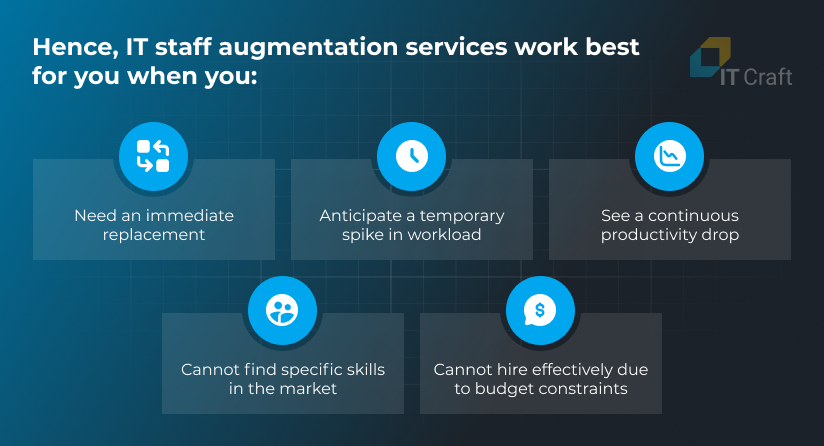
- Need an immediate replacement.The time it takes to fill a development position averages 30 to 60 days, where senior roles take 35% longer to fill. This timeline might be too long when project completion is your top priority, e.g., for an MVP launch.
- Anticipate a temporary spike in workload. Your in-house team might need help with updates and scale during the peak user activity, e.g., Black Friday for online shops or sales of flight tickets before a holiday season.
- See a continuous productivity drop. The growing workload holds the in-house team back. Due to increased routine tasks, the team cannot focus on strategic issues such as tech debt, test automation, or scalability.
- Cannot find specific skills in the market. The team might require consulting from specialists who have rare skills, e.g., in infrastructure setup or building a CI/CD pipeline.
- Cannot hire effectively due to budget constraints. Programmers could resign at any time. Replacement costs can take 20%–25% of base salary plus related overhead costs, translating into $35,800 and $66,250 when considering the total yearly salary of $179,000–$265,000 for a senior software engineer.
Also, add 1–6 months of onboarding when a person does not work with full productivity. Team augmentation reduces these expenses.
5
How to Manage an Augmented Team
You hire remote workers who are not sitting in the same room with you. Not even in the same city or country. Their ability matters most, but changes in your workflow might be necessary.
Unexpected barriers might occur:
- low time overlap
- differences in working approaches
- lack of project understanding & processes
and more
Hence, you must be prepared to coordinate a remote team, encouraging each member to work autonomously and proactively. Creating a transparent working environment and a common view of the project is crucial.
Keep the following points in mind:
- Aligning goals and vision
All team members—in-house and external—must be aware of the business goals. You need to eliminate risks that developers start working on details that do not provide value to the project.
Team augmentation requires adjustments in working processes to make everyone efficient. Make sure engineers understand each other’s roles, responsibilities, and routines. They have a common view of the tech stack and instruments.
- Building collaborative culture
It is impossible to hand over a list of tasks for programmers then wait until it is done. Ensure they have a contact point to address any questions or ask for advice. The key to success is to have them remain in touch with colleagues to solve emerging issues fast.
- Engaging open communication
Ensure everyone can speak about emerging problems. Provide constructive feedback on what could be done better. Listen to suggestions on possible workflow improvements.
Treat all staff as your team. Augmented team members work efficiently and proactively, knowing they are respected and heard. Encourage them to share their vision and to offer solutions.
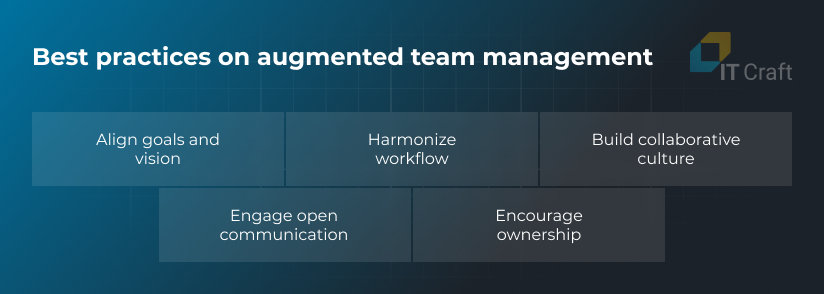
6
Security Measures When Hiring External Team Members
It is essential to keep security at an elevated level when remote team members are integrated into the workflow.
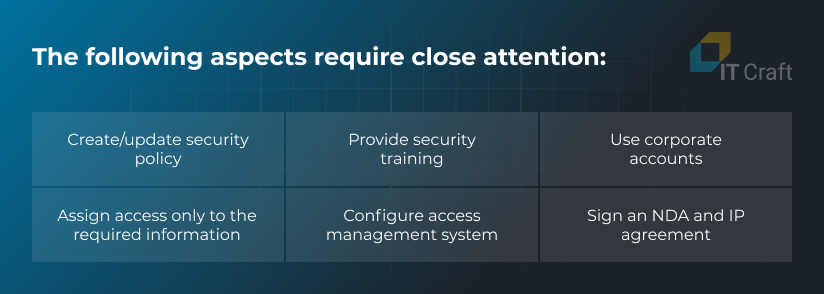
- Create/update the security policy
Staff augmentation is a great opportunity to reconsider and improve the company’s security policy. Check workflow against new challenges. Invest in extra security measures. Schedule security audits every six months.
- Provide security training
When you have a policy update, it is essential that everyone knows it and understands what to do. Increase staff awareness of security routines, possible risks, and everyone’s actions in an emergency.
Create corporate emails and profiles for the new team members, which they will use when working with your resources and within your internal system. Add them to corporate spaces and management systems to facilitate onboarding.
- Assign access only to the required information
Determine the access level and set permissions for those specific resources team members require to fulfill their duties. Also, ensure their access to tech documentation they need for reference. Do not set up unnecessary barriers that slows progress.
- Configure access management system
An access management system enables secure handling of various secrets (tokens, passwords, certificates, etc.). It lets you respond to role changes, monitor inventory, and minimize the consequences of possible breach/identity theft.
- Sign an NDA and IP agreement
Ensure you cover sensitive contract clauses with an NDA or an IP agreement to keep all your trade secrets safe. For instance, IT Craft managers sign an NDA before the first contact occurs to ensure our clients can discuss their problems freely.
Do you need tech experts who can start ASAP?
Share your project needs with us to see how we can help you keep pace.
Contact Us
7
Pros and Cons of Staff Augmentation Model
Let’s discuss the benefits and limits of staff augmentation models for businesses.
Pros of Staff Augmentation
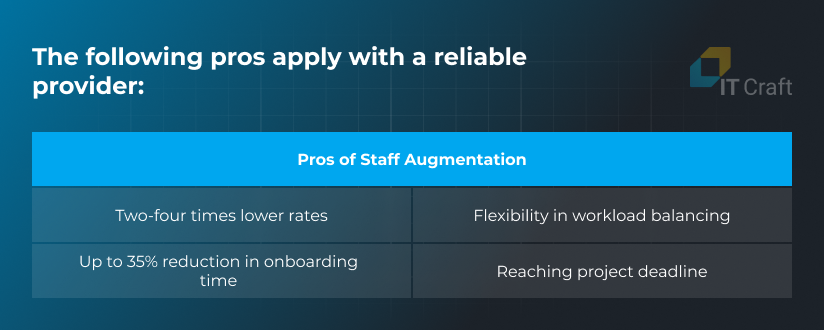
- Pro 1. Two-four times lower rates
The direct cost of labor is lower when hiring an augmented team. For instance, Central and Eastern European hourly rates are $30 – $65, compared to $65 – $170 in Western Europe and $100 – $250 in USA/Canada for the same expertise level. Risks of budget overspend decrease.
- Pro 2. Up to 35% reduction in onboarding time
It takes 30 – 60 days to fill one in-house tech position. A new specialist can be added within 14+ days when opting for staff augmentation, substantially increasing the company’s flexibility. The team can be scaled faster, requiring less working time on the in-house team’s side.
- Pro 3. Flexibility in workload balancing
Businesses distribute workload more efficiently while eliminating capacity constraints. Productivity of the in-house team increases. When the project scope drops precipitously, the in-house team remains intact. The external augmentation team switches to the next project. Businesses keep up with budget limits.
- Pro 4. Reaching project deadline
Staff augmentation can make a difference under a tight deadline. Specialists might not be available for a quick hire in the local market for a reasonable cost or not possess the required expertise. Businesses bridge the skill gap with experienced engineers from other geographic locations fast, meeting short-term goals.
Cons of staff augmentation
Cons might emerge on both sides. A provider may not have enough expertise or share the client’s mindset.
The client’s processes might be a good fit to incorporate outside experts.
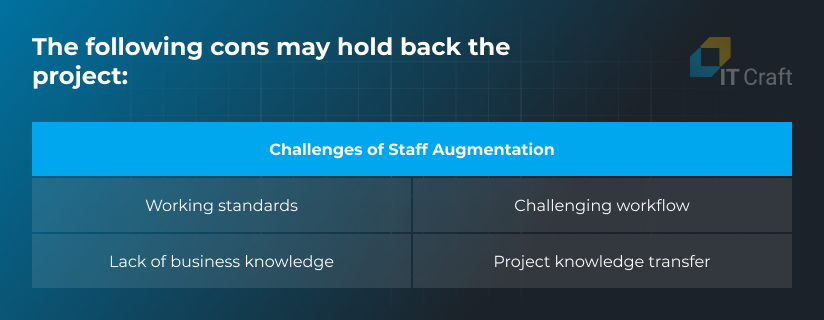
Finding a reliable provider who shares a sound work ethic is crucial. New members must become a part of the team without any need for micromanagement on your side. Remember, the lowest hourly rates mean more needed supervision. It leads to waste of resources on your side, resulting in higher indirect costs.
- Con 2. Lack of business knowledge
New team members need more onboarding time when a business has unique processes or operates in a narrow, context-dependent niche. To ensure successful augmentation, look for a vendor with similar completed projects.
- Con 3. Challenging workflow
Both augmented staff and the company hiring them must adjust. The client company’s processes must be accommodating to remote team members, e.g., consider time zone mismatches, and apply scrum practices and communication guidelines, ensuring everyone’s fast response.
- Con 4. Project knowledge transfer
Documenting is an essential part of all processes. Members of the augmented team must keep track record of their work and contribute to information sharing, ensuring everyone understands what they have done on the project and why.
8
How to Succeed with Staff Augmentation
The following points will help you understand augmented staff meaning for your processes:
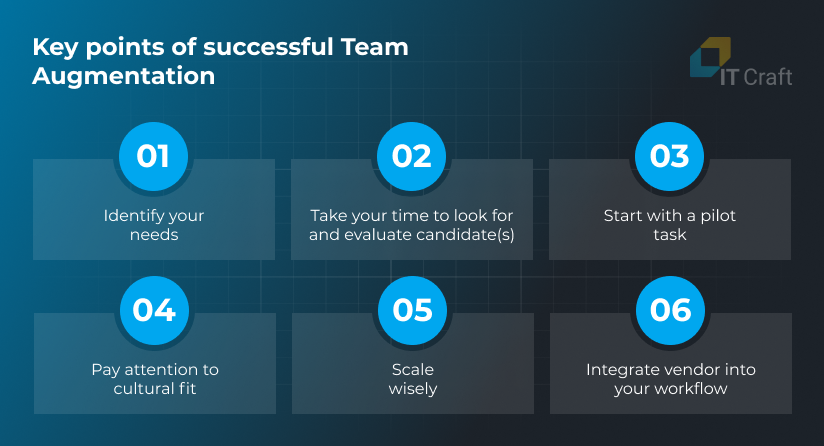
Identify your needs
Answer the following questions before you start any search:
- What skill gaps do I want to cover with technical staff augmentation?
- What are my end goals? What do I expect from the external professional(s)?
- What is the planned scope of work? Will the scope increase?
- How much time can I spend managing external developers?
The answers will help you formulate expectations from team augmentation.
Take your time to look for and evaluate candidate(s)
Even if there is an urgent need for professionals on a project, it makes sense to choose carefully. Check the vendor’s portfolio for similar cases. Study reviews and online feedback.
Start with a pilot task
Action proves performance. Start small to see whether augmented staff understands the project problems and chooses the right path to their solutions.
A small pilot task also indicates whether new team members keep pace with your timeline or become a roadblock on the project, creating extra hassle and costs.
Pay attention to cultural fit
Miscommunication caused by cultural differences becomes the primary source of hidden costs. When new team members have low cultural awareness, tasks are completed slower, and project managers spend their time on micromanagement. Always choose a team with a work ethic similar to yours.
Scale wisely
Give the extended team a heads-up on possible changes in workload before cooperation starts, so they can be well prepared. When you rapidly increase the scope of work, your team might struggle to scale and/or adapt to the new scope. It can also cause problems for the vendor in finding a suitable developer for the project. Reliable vendors do not just put a body in a seat and charge more.
Integrate vendor into your workflow
Again, do not leave new engineers working on their own: integrate them into your business’s workflow. Ensure in-house engineers are aware of the reasons for IT staff augmentation. It helps eliminate tensions and boost productivity for both teams, enabling them to meet even near-impossible deadlines.
9
How Staff Augmentation Works at IT Craft
IT Craft accurately studies each client’s particular request. It then offers the best terms based on unique needs and limitations.
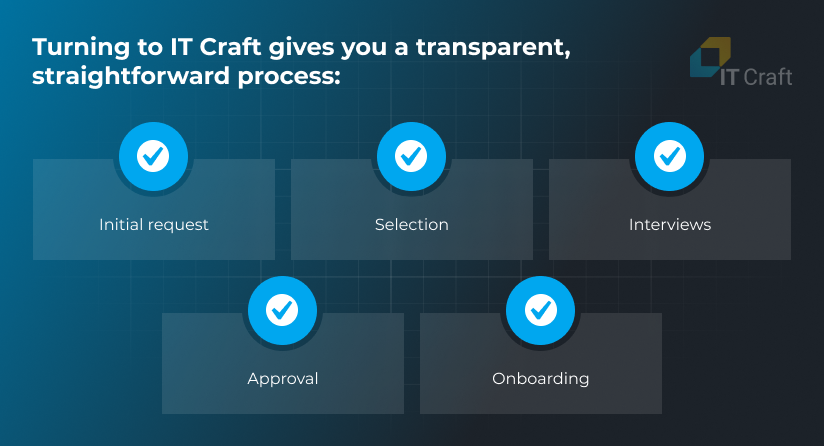
Our five-step path to successful IT staff augmentation services:
01 Initial Request
We sign an NDA with you then study your request and make a list of suitable candidates.
02 Selection
You receive candidates’ CVs within 3+ days, which you evaluate. We schedule interviews with those you like and consider suitable.
03 Interviews
You meet approved candidates on a video call and observe their skills/needed expertise and the offered solution path to your problem.
04 Approval
Once you approve specific candidates, we negotiate on further cooperation terms, ensuring complete mutual understanding.
05 Onboarding
When the agreement is finalized and signed, the assigned engineers start working as a part of your team.
Depending on the request’s complexity, the entire process takes 2+ weeks. Also, IT Craft offers a 1-month probation period for staff augmentation services. As a client, you need this time to evaluate the level of our services.
Jan Goetgeluk, Founder and CEO, Omni
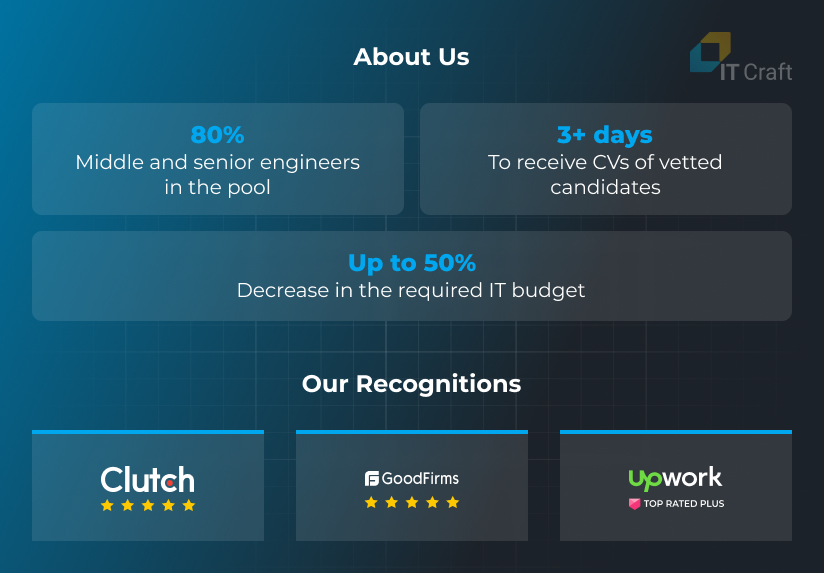
!
Summary
What is staff augmentation’s benefit for hiring businesses?
There are many. Businesses can:
- Stay on track with their business growth plans.
- Retain control over their software systems.
- Keep their budget under control.
Talent augmentation is the perfect option for companies that want to scale flexibly and wisely.
As with any cooperation, concerns and risks remain. Businesses can eliminate them by determining their aims and expectations with a service provider.
Whatever option you choose, choose expertise and a high-quality working culture.













